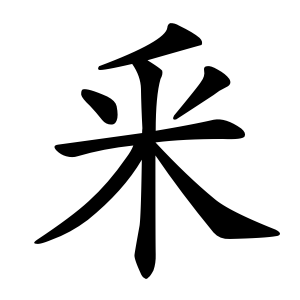釆
- to distinguish;
- to separate;
- to discriminate;
Etymology
According to the Shuowen Jiezi (説文解字 shuōwén jiězì), its origin is a pictograph representing the split claws of an animal. The idea of distinguishing arose from hunters identifying the type of prey based on animal tracks.
Usage in Korean
When used as a radical, it generally conveys meanings related to "distinguishing" or "discrimination."
Similar shape characters
Characters with 釆
20 strokes
釆
나눌
변
nanul
byeon
Kangxi radical:165
Strokes:7
Unicode:U+91C6
Cangjie input:
- 竹火木 (HFD)
- 難竹火木 (XHFD)
Composition:
- ⿱ 丿 米
- ⿻ 禾 丷
